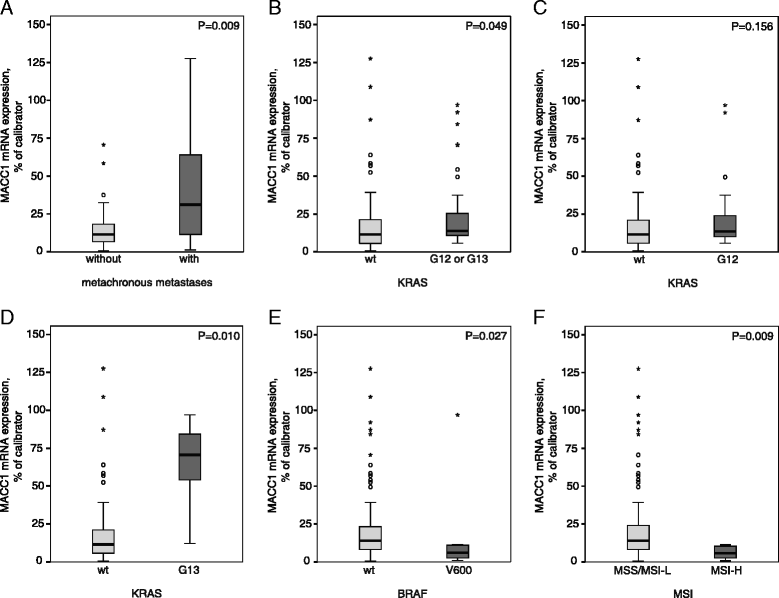High MACC1 expression in combination with mutated KRAS G13 indicates poor survival of colorectal cancer patients
- PMID: 25742883
- PMCID: PMC4335361
- DOI: 10.1186/s12943-015-0316-2
High MACC1 expression in combination with mutated KRAS G13 indicates poor survival of colorectal cancer patients
Abstract
Background: The metastasis-associated in colon cancer 1 (MACC1) gene has been identified as prognostic biomarker for colorectal cancer (CRC). Here, we aimed at the refinement of risk assessment by separate and combined survival analyses of MACC1 expression with any of the markers KRAS mutated in codon 12 (KRAS G12) or codon 13 (KRAS G13), BRAF V600 mutation and MSI status in a retrospective study of 99 CRC patients with tumors UICC staged I, II and III.
Findings: We showed that only high MACC1 expression (HR: 6.09, 95% CI: 2.50-14.85, P < 0.001) and KRAS G13 mutation (HR: 5.19, 95% CI: 1.06-25.45, P = 0.042) were independent prognostic markers for shorter metastasis-free survival (MFS). Accordingly, Cox regression analysis revealed that patients with high MACC1 expression and KRAS G13 mutation exhibited the worst prognosis (HR: 14.48, 95% CI: 3.37-62.18, P < 0.001). Patients were classified based on their molecular characteristics into four clusters with significant differences in MFS (P = 0.003) by using the SPSS 2-step cluster function and Kaplan-Meier survival analysis.
Conclusion: According to our results, patients with high MACC1 expression and mutated KRAS G13 exhibited the highest risk for metachronous metastases formation. Moreover, we demonstrated that the "Traditional pathway" with an intermediate risk for metastasis formation can be further subdivided by assessing MACC1 expression into a low and high risk group with regard to MFS prognosis. This is the first report showing that identification of CRC patients at high risk for metastasis is possible by assessing MACC1 expression in combination with KRAS G13 mutation.
Figures



Similar articles
-
Integrative marker analysis allows risk assessment for metastasis in stage II colon cancer.Ann Surg. 2012 Nov;256(5):763-71; discussion 771. doi: 10.1097/SLA.0b013e318272de87. Ann Surg. 2012. PMID: 23095620
-
MACC1 mRNA levels predict cancer recurrence after resection of colorectal cancer liver metastases.Ann Surg. 2013 Jun;257(6):1089-95. doi: 10.1097/SLA.0b013e31828f96bc. Ann Surg. 2013. PMID: 23665971
-
Poor prognosis of KRAS or BRAF mutant colorectal liver metastasis without microsatellite instability.J Hepatobiliary Pancreat Sci. 2013 Feb;20(2):223-33. doi: 10.1007/s00534-012-0531-9. J Hepatobiliary Pancreat Sci. 2013. PMID: 23010994
-
K-Ras mutation and prognosis of colorectal cancer: a meta-analysis.Hepatogastroenterology. 2015 Jan-Feb;62(137):19-24. Hepatogastroenterology. 2015. PMID: 25911860 Review.
-
[Prognostic biomarkers for metastatic colorectal cancer].Pathologe. 2016 Nov;37(Suppl 2):180-185. doi: 10.1007/s00292-016-0204-6. Pathologe. 2016. PMID: 27638531 Review. German.
Cited by
-
Clinical relevance of circulating MACC1 and S100A4 transcripts for ovarian cancer.Mol Oncol. 2019 May;13(5):1268-1279. doi: 10.1002/1878-0261.12484. Epub 2019 Apr 15. Mol Oncol. 2019. PMID: 30927479 Free PMC article. Clinical Trial.
-
MACC1 Correlates with Tumor Progression and Immune Cell Infiltration of Colon Adenocarcinoma and is Regulated by the lncRNA ZFAS1/miR-642a-5p Axis.J Oncol. 2022 Dec 12;2022:8179208. doi: 10.1155/2022/8179208. eCollection 2022. J Oncol. 2022. PMID: 36545127 Free PMC article.
-
Association of KRAS Mutation and Gene Pathways in Colorectal Carcinoma: A Transcriptome- and Methylome-Wide Study and Potential Implications for Therapy.Int J Mol Sci. 2024 Jul 25;25(15):8094. doi: 10.3390/ijms25158094. Int J Mol Sci. 2024. PMID: 39125664 Free PMC article.
-
KRAS inhibitors may prevent colorectal cancer metachronous metastasis by suppressing TGF‑β mediated epithelial‑mesenchymal transition.Mol Med Rep. 2025 Jan;31(1):24. doi: 10.3892/mmr.2024.13389. Epub 2024 Nov 14. Mol Med Rep. 2025. PMID: 39540351 Free PMC article.
-
Combinatorial treatment with statins and niclosamide prevents CRC dissemination by unhinging the MACC1-β-catenin-S100A4 axis of metastasis.Oncogene. 2022 Sep;41(39):4446-4458. doi: 10.1038/s41388-022-02407-6. Epub 2022 Aug 25. Oncogene. 2022. PMID: 36008464 Free PMC article.
References
Publication types
MeSH terms
Substances
LinkOut - more resources
Full Text Sources
Other Literature Sources
Medical
Research Materials
Miscellaneous

